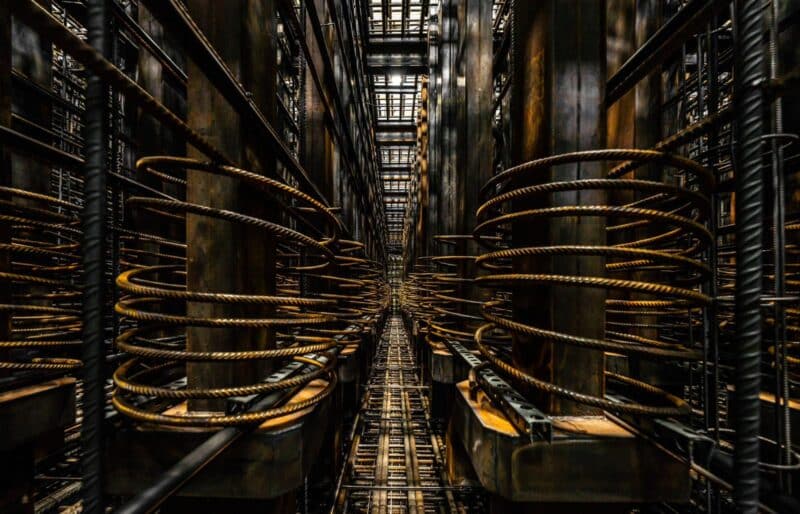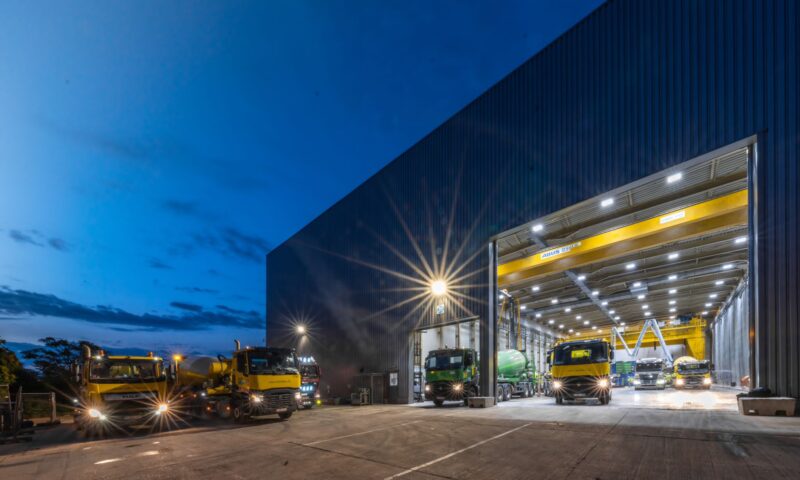ZF Wind Power produces gearcases for wind turbines. In order to facilitate innovated, larger gearcases, the dream was to have the most powerful test site in the entire wind industry. Their Danish partner R&D Test Systems relied on edibo for the constructional framework. The construction of this test site became a challenge that has proven to be larger than life, because the dimensions, forces and powers in this project really fired the imagination.
The project: test site construction in 3 phases
The works edibo carried out took place in the existing ZF Wind Power buildings at our hometown of Lommel. It was up to our constructive challengers to monitor three phases (see below for a detailed overview):
- All the preliminary works for the new test site
- Foundation work for a gantry crane (300 tonnes) and for the main foundation
- Construction of the main foundation of the new testing facility
The challenges
Estimator/Salesman Roy Dries and Project Manager Louis Corens were first in line for the construction works of this test site with its near astronomical proportions. Consequently, the project came with a number of feisty challenges.
Challenger Roy Dries: “This project is disproportionate, something which you’ll probably only encounter once in your life. For us, the dimensions of this assignment were unprecedented, a project where we couldn’t just fall back on our own expertise. We had to constantly challenge ourselves and obtain information and specialised advice from the right internal and external parties in order to bring this project to a successful conclusion.”
1. Reinforcement in multiple layers
“Testing gearcases requires massive forces. Forces that should be absorbed effortlessly by the main foundation”, emphasises Roy Dries.
“The reinforcement of this main foundation is completely structured from loose bars in a variety of diameters, which we braided and joint together on site in the construction pit. 359 strong point boxes – joint hollow metal tubes – have been dispersed over the entire foundation with ultimate precision. To keep these in place we designed a steel structure that can act for the positioning of these tubes as well as support upper reinforcements.”
2. Pouring marathon under strict supervision
The main foundation is a massive block of 1,700 m³ of concrete. “Our client demanded we poured the concrete in a single phase – without interruption”, project manager Louis Corens proceeds. “That equals about 170 hauls that needed to connect seamlessly. Ultimately, this proved to be the absolute priority of this project. Absolutely nothing can go wrong in a moment like this, not on site and not at the concrete plants. Therefore, it was crucial to conclude waterproof agreements with the concrete supplier”.
“To allow continuous monitoring of the flow fill, maturity and primarily temperature of the concrete, we integrated several sensors connected to relevant measurement equipment. In order to be able to control the temperature, we installed an entire cooling station in and around the pit.”
“Eventually, we were able – also thanks to the indispensable edibo creativity – to keep everything under control. We reused the groundwater that we pumped from draining the wellpoint to then mix it through the fresh concrete. This prevented the cooling containers from reaching or even going over their limit.”

3. Atypical workflow
“Concrete cooling, calling in and installing cooling containers, engineering firms that needed to calculate cooling procedures, supplying specific measurement equipment, setting up simulations, precision measurements accurate up to 1mm… Especially in the third construction phase we needed to find the right specialists in their field. This resulted in an extra strict and elaborated approach during the preliminary phase, since the margin of error was extremely small in this project.”
4. Race against the clock
“The timing in this project was very tight”, Louis Corens stresses. “Phases 1 and 2 had only just been completed when phase 3 also needed to be finished before the approaching construction leave. We couldn’t rely on previous experiences from similar past projects, so the pressure was always on. Thanks to our proactive approach, we did manage to handle this perfectly.”
5. English as medium of communication
“For this project, building consultant ZF Wind Power was assisted by a renowned Danish engineering firm specialising in test systems in the wind turbine industry. Due to this project’s international nature we were required to communicate mainly in English. Not only during site meetings or consultations but also during the development of the entire file and the general roadmap. This was an additional challenge because nobody could afford to have something get ‘lost in translation’. Everything needed to remain within the specified tolerances.”
6. Teamwork
“Every edibo worker involved had to step out of their comfort zone for this project. The collegiality and joint motivation were an absolute joy to behold”, Roy Dries and Louis Corens reflect unanimously.
“For instance, at one point our technicians had to sand away insulation material to the very millimetre while our colleagues in the workshop were becoming skilled specialists in installing cooling pipes. One of our stability engineers can now be considered an expert in concrete cooling and our land surveyor has become a true athlete, seeing how he had to manoeuvre to perform certain measurements.”
Typical edibo?
How we as constructive challengers make the difference at constructing this test site? Roy Dries: “I think the numbers speak for themselves. You can’t successfully deliver a project like this without super strict and clear agreements, an ironclad follow-up and intensive communication.”
Colleague Louis Corens couldn’t agree more: “We had to reinvent ourselves time and again in every field, which we did magnificently, within all the departments of our company. We clearly had the confidence of our clients throughout the different phases of this project, which confirms that we performed our part as constructive challengers with verve”, Roy and Louis conclude.
Ready to entrust us with your sky high project?
This project shows that we as industrial contractors with 40+ years of experience are more than ever ready to take on the most complex challenges; across industries.
What role can we play in your future project? Our biggest strength is our ability to adapt our organisation and expertise to every type of project. Make an appointment and tell us more about your industrial construction plans. In the meantime, take a look at some of our realisations.

A detailed view of the three phases
Phase 1: all the preliminary work for the new test site
- Demolishing existing floors and foundations in one of the existing buildings
- Creating a gate opening of 9m by 9m and installing a ‘Megadoor’
- Filling a 72-m basement with approximately 1,500 m² of soil
- Making additional entrance doors and sectional doors for the new test site
Phase 2: foundation works for gantry crane (300 tonnes) and for the main foundation
- Creating (2m50 high, 2m wide) foundations for the construction of the gantry crane over the entire length of the building, with reinforced recesses and anchoring points
- Making a construction pit shoring (33m x 12m x 5m) in the existing building by means of secant piles
- Digging and draining soil from the site
- Fitting insulation and mats from recycled rubber granulates to the outside of the construction pit to absorb all the vibrations for the adjacent foundations
- Pouring new concrete floors with a thickness of 40 cm over the entire test site with floor lowering in various locations. Here, we integrated a solid steel plate to act as subsurface for the new testing facility.
- Pouring a concrete floor in the construction pit, forming the base for phase 3.
Phase 3: building the main foundation of the new testing facility
- Arranging the layout and 100% vertical drilling of 359 anchoring points into the base concrete slab
- Fitting 250,000 kg of rebar – up to 32 mm in diameter – accurate to the centimetre, in various levels of on average 8 layers
- Fitting a steel structure in the main foundation (about 30 tonnes) to keep the top bars and 359 anchoring points in place
- Fitting 359 strong point boxes with an accuracy up to 3 mm, where the anchoring points (M80) will be fitted through
- Designing, installing and completing a concrete cooling system
- Fitting 3,000 m of cooling pipes throughout the foundation, 7 cooling units of 2MW and 24-hour monitoring to warrant an optimal temperature of the concrete
- Pouring 1,700 m³ of concrete in less than one day
- Finishing the foundation with epoxy in the areas without solid steel plate.
